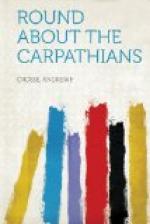The old Dacians were strong enough we know to exact a yearly tribute from Domitian: it was for this insult that Trajan marched upon Dacia, defeating Decebalus at Klausenburg, in the heart of Transylvania, which was at the time their greatest strong-hold. It was after this that the Dacian king retreated upon Sarmisegethusa, and there Trajan came down upon them through the Iron Gate Pass. Unable to defend themselves, the Dacians set fire to their royal city and fled to the mountains. On these ruins the Romans, ever ready to appropriate a good site, erected the city of Ulpia Trajana, connecting it by good roads with the existing Roman colonies at Karlsburg and Klausenburg.
Unless the traveller had brought historic facts with him to Gradischtie, he would hardly be induced to search for tesselated pavements and relics of royalty amongst the piggeries of this dirty Wallack village. It is a literal fact that a very fine specimen of Roman pavement exists here in an unsavoury outhouse, not unknown to pigs and their congeners.
This Hatszeg Valley, in the county of Hunyad, has long been celebrated for the richness of its Dacian and Roman antiquities. These treasures have unfortunately been dispersed about amongst various general collections of antiquity, instead of being well kept together as illustrative of local facts and history. The archaeologist must seek for these remains specially in the Ambras collection of the Archaeological Museum at Vienna, the National Museum at Buda Pest, in the Bruckenthal Museum at Herrmannstadt, also in the Klausenburg Museum. Dr H. Finaly, Professor of Archaeology at the University of Klausenburg, is the great living authority on this interesting subject. To him I am indebted for some information, conveyed in a letter to a private friend.[12] The professor alludes to the fact of the treasures being all carried away, adding that on the spot very little is to be found except the remains of Roman encampments (castra stativa), Roman military roads, together with the foundations of buildings, the materials of which however are usually carried away by the peasants. Nor are the records of former interesting discoveries to be found in one volume, but are dispersed about in the various publications of learned societies, such as the ‘Archaelogiaei Koezlemenyek’ of the Hungarian Academy, the ’Year-Book of the Transylvanian Museum,’ and ‘Verhandlungen und Mittheilungen’ of the Verein fur Siebenbuergische Landeskunde of Herrmannstadt.
That the materials of the old Roman buildings are now used for baser purposes, one has abundant proof; even in my hurried inspection I saw many a sculptured stone and fragment of fluted column doing duty as the support of a wretched Wallack shanty. Another evidence of the Roman occupation of the country occurs in the case of certain plants now found growing wild, which are exotic to the soil. This, I am told, occurs in a marked manner at Thorda, which was known to be a Roman colony. The plants, it may be presumed, were brought thither by the Roman legionaries. The most picturesque bit of Roman antiquity is the Temple at Demsus, within a short drive of Varhely. It is on a small eminence overlooking a cluster of Wallack dwellings, and has long been used as a church by these people.




